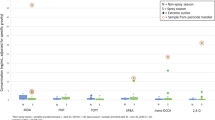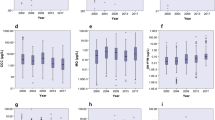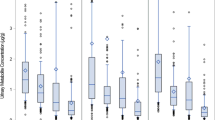Abstract
Chlorpyrifos (CPF) is applied seasonally in Egypt by adolescent agricultural workers and the extent of occupational exposure and the potential for environmental CPF exposure in this population is poorly understood. Adolescent pesticide applicators (n=57; 12–21 years of age) and age-matched non-applicators (n=38) from the same villages were followed for 10 months in 2010, spanning pre-application through post-application. Eight urine and five blood samples were collected from participants within this time period. Blood acetylcholinesterase and butyrylcholinesterase (BChE; exposure/effect biomarker) and urine 3,5,6-trichloro-2-pyridinol (TCPy; exposure biomarker) were used to assess occupational CPF exposures in pesticide applicators and environmental exposures in non-applicators. Applicators demonstrated significantly higher TCPy concentration and BChE depression than non-applicators throughout CPF application. This difference persisted for 4–7 weeks after the cessation of agricultural spraying. However, both groups exhibited significantly elevated TCPy and depressed BChE, compared with their respective baseline. The peak TCPy levels during the spray season (95% confidence interval (CI)) for non-applicators and applicators reached 16.8 (9.87–28.5) and 137 (57.4–329) ug/g creatinine, respectively. BChE levels (95% CIs) during the spray were as follows: 1.47 (1.28–1.68) for non-applicators and 0.47 (0.24–0.94) U/ml for applicators. The longitudinal assessment of CPF biomarkers provided robust measures of exposure and effect throughout CPF application in adolescents and revealed significant exposures in both applicators and non-applicators. Biomarker data in the non-applicators, which mirrored that of the applicators, indicated that non-applicators received environmental CPF exposures. This suggests that similar exposures may occur in other residents of this region during periods of pesticide application.
This is a preview of subscription content, access via your institution
Access options
Subscribe to this journal
Receive 6 print issues and online access
$259.00 per year
only $43.17 per issue
Buy this article
- Purchase on Springer Link
- Instant access to full article PDF
Prices may be subject to local taxes which are calculated during checkout




Similar content being viewed by others
References
Farahat TM, Abdel Rasoul GM, Amr MM, Shebl MM, Farahat FM, Anger WK . Neurobehavioural effects among workers occupationally exposed to organophosphorous pesticides. Occup Environ Med 2003; 60: 279–286.
Farahat FM, Fenske RA, Olson JR, Galvin K, Bonner MR, Rohlman DS et al Chlorpyrifos exposures in Egyptian cotton field workers. Neurotoxicology 2010; 31: 297–304.
Farahat FM, Ellison CA, Bonner MR, McGarrigle BP, Crane AL, Fenske RA et al Biomarkers of chlorpyrifos exposure and effect in Egyptian cotton field workers. Environ Health Perspect 2011; 119: 801–806.
Jiang W, Duysen EG, Hansen H, Shlyakhtenko L, Schopfer LM, Lockridge O . Mice treated with chlorpyrifos or chlorpyrifos oxon have organophosphorylated tubulin in the brain and disrupted microtubule structures, suggesting a role for tubulin in neurotoxicity associated with exposure to organophosphorus agents. Toxicol Sci 2010; 115: 183–193.
Middlemore-Risher ML, Buccafusco JJ, Terry AV . Repeated exposures to low-level chlorpyrifos results in impairments in sustained attention and increased impulsivity in rats. Neurotoxicol Teratol 2010; 32: 415–424.
Rohlman DS, Anger WK, Lein PJ . Correlating neurobehavioral performance with biomarkers of organophosphorous pesticide exposure. Neurotoxicology 2011; 32: 268–276.
Salvi RM, Lara DR, Ghisolfi ES, Portela LV, Dias RD, Souza DO . Neuropsychiatric evaluation in subjects chronically exposed to organophosphate pesticides. Toxicol Sci 2003; 72: 267–271.
Speed HE, Blaiss CA, Kim A, Haws ME, Melvin NR, Jennings M et al Delayed reduction of hippocampal synaptic transmission and spines following exposure to repeated, subclinical doses of organophosphorus pesticide in adult mice. Toxicol Sci 2011; 125: 196–208.
Huen K, Harley L, Bradman A, Eskenazi B, Holland N . Longitudinal changes in PON1 enzymatic activities in Mexican–American mothers and children with different genotypes and haplotypes. Toxicol Appl Pharmacol 2010; 244: 181–189.
Grandjean P, Harari R, Barr DB, Debes F . Pesticide exposure and stunting as independent predictors of neurobehavioral deficits in Ecuadorian school children. Pediatrics 2006; 117: e546–e556.
Eskenazi B, Marks AR, Bradman A, Harley K, Barr DB, Johnson C et al Organophosphate pesticide exposure and neurodevelopment in young Mexican-American children. Environ Health Perspect 2007; 115: 792–798.
Bjorling-Poulsen M, Andersen HR, Grandjean P . Potential developmental neurotoxicity of pesticides used in Europe. Environ Health 2008; 7: 50.
Abdel Rasoul GM, Abou Salem ME, Mechael AA, Hendy OM, Rohlman DS, Ismail AA . Effects of occupational pesticide exposure on children applying pesticides. Neurotoxicology 2008; 29: 833–838.
Rothlein J, Rohlman D, Lasarev M, Phillips J, Muniz J, McCauley L . Organophosphate pesticide exposure and neurobehavioral performance in agricultural and non-agricultural Hispanic workers. Environ Health Perspect 2006; 114: 691–696.
Amitai G, Moorad D, Adani R, Doctor BP . Inhibition of acetylcholinesterase and butyrylcholinesterase by chlorpyrifos-oxon. Biochem Pharmacol 1998; 56: 293–299.
Foxenberg RJ, McGarrigle BP, Knaak JB, Kostyniak PJ, Olson JR . Human hepatic cytochrome p450-specific metabolism of parathion and chlorpyrifos. Drug Metab Dispos 2007; 35: 189–193.
Fabiny DL, Ertingshausen G . Automated reaction-rate method for determination of serum creatinine with the CentrifiChem. Clin Chem 1971; 17: 696–700.
Lang KY, Zeger SL . Longitudinal data analysis using generalized linear models. Biometrika 1986; 73: 13–22.
Hardin JW, Hilbe JM . Generalized Estimating Equations. Chapman and Hall New York, NY. 2003.
Aitkin M, Anderson D, Francis B, Hinde J . Statistical Modelling in GLIM. Oxford University Press New York, NY. 1989.
Bacon DW, Watts DG . Estimating the transition between two intersecting straight lines. Biometrika 1971; 58: 525–534.
Nolan RJ, Rick DL, Freshour NL, Saunders JH . Chlorpyrifos: pharmacokinetics in human volunteers. Toxicol Appl Pharmacol 1984; 73: 8–15.
Eaton DL, Daroff RB, Autrup H, Bridges J, Buffler P, Costa LG et al Review of the toxicology of chlorpyrifos with an emphasis on human exposure and neurodevelopment. Crit Rev Toxicol 2008; 38 (Suppl 2): 1–125.
CDC (Centers for Disease Control and Prevention) National Report on Human Exposure to Environmental Chemicals 2009 Available at http://www.cdc.gov/exposurereport (accessed 18 February 2012).
US EPA. Chlorpyrifos Revised Risk Assessment and Agreement with Registrants. US Environmental Protection Agency Washington, DC. 2000.
Whyatt RM, Garfinkel R, Hoepner LA, Andrews H, Holmes D, Williams MK et al A biomarker validation study of prenatal chlorpyrifos exposure within an inner-city cohort during pregnancy. Environ Health Perspect 2009; 117: 559–567.
Nigg HN, Knaak JB . Blood cholinesterases as human biomarkers of organophosphorus pesticide exposure. Rev Environ Contam Toxicol 2000; 163: 29–111.
Cholinesterase Monitoring Washington Administrative Code, Chapter 296–307, Part J-1 2004.
Ostergaard D, Viby-Mogensen J, Hanel HK, Skovgaard LT . Half-life of plasma cholinesterase. Acta Anaesthesiol Scand 1988; 32: 266–269.
Garabrant DH, Aylward LL, Berent S, Chen Q, Timchalk C, Burns CJ et al Cholinesterase inhibition in chlorpyrifos workers: Characterization of biomarkers of exposure and response in relation to urinary TCPy. J Expo Sci Environ Epidemiol 2009; 19: 634–642.
London L, Beseler C, Bouchard MF, Bellinger DC, Colosio C, Grandjean P et al Neurobehavioral and neurodevelopmental effects of pesticide exposures. Neurotoxicology 2012; 33: 887–896.
Costa LG, Li WF, Richter RJ, Shih DM, Lusis A, Furlong CE . The role of paraoxonase (PON1) in the detoxication of organophosphates and its human polymorphism. Chem Biol Interact 1999; 119-120: 429–438.
Costa LG, Cole TB, Vitalone A, Furlong CE . Measurement of paraoxonase (PON1) status as a potential biomarker of susceptibility to organophosphate toxicity. Clin Chim Acta 2005; 352: 37–47.
Koch D, Lu C, Fisker-Andersen J, Jolley L, Fenske RA . Temporal association of children’s pesticide exposure and agricultural spraying: report of a longitudinal biological monitoring study. Environ Health Perspect 2002; 110: 829–833.
Quandt SA, Chen H, Grzywacz JG, Vallejos QM, Galvan L, Arcury TA . Cholinesterase depression and its association with pesticide exposure across the agricultural season among Latino farmworkers in North Carolina. Environ Health Perspect 2010; 118: 635–639.
Acknowledgements
We thank the Egyptian Ministry of Agriculture and the adolescents and their parents for their participation, Steve Hutton (Dow Agrosciences, Indianapolis, IN, USA) for providing 13C-15N-3,5,6-TCP, Barbara McGarrigle for the urinary TCPy analytical work, and the Research Team at the Menoufia University. The work was supported by the National Institute of Environmental Health Sciences (NIEHS, grants nos ES017223 and NIEHS F30 ES020655).
Disclaimer
The content is solely the authors' responsibility and does not necessarily represent official views of NIEHS.
Author information
Authors and Affiliations
Corresponding author
Ethics declarations
Competing interests
The authors declare no conflict of interest.
Additional information
Supplementary Information accompanies the paper on the Journal of Exposure Science and Environmental Epidemiology website
Supplementary information
Rights and permissions
About this article
Cite this article
Crane, A., Abdel Rasoul, G., Ismail, A. et al. Longitudinal assessment of chlorpyrifos exposure and effect biomarkers in adolescent Egyptian agricultural workers. J Expo Sci Environ Epidemiol 23, 356–362 (2013). https://doi.org/10.1038/jes.2012.113
Received:
Accepted:
Published:
Issue Date:
DOI: https://doi.org/10.1038/jes.2012.113
Keywords
This article is cited by
-
The association between organophosphate insecticides and blood pressure dysregulation: NHANES 2013–2014
Environmental Health (2022)
-
Longitudinal Assessment of Chlorpyrifos Exposure in Farmers and Residents of an Italian Alpine Region
Exposure and Health (2021)
-
Acetylcholinesterase, Butyrylcholinesterase and Glutathione S-Transferase Enzyme Activities and Their Correlation with Genotypic Variations Based on GST M1 and GST T1 Loci in Long Term-Pesticide-Exposed Tea Garden Workers of Sub-Himalayan West Bengal
Toxicology and Environmental Health Sciences (2019)
-
Acetylcholinesterase activity and time after a peak pesticide-use period among Ecuadorian children
International Archives of Occupational and Environmental Health (2018)
-
A global perspective on the influence of environmental exposures on the nervous system
Nature (2015)



